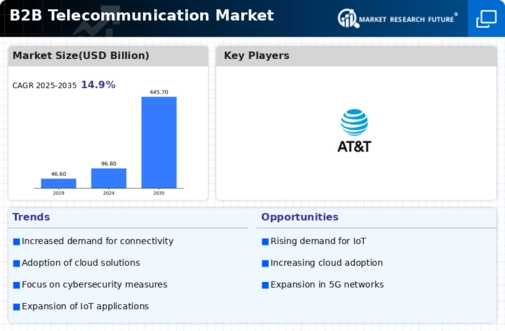Emergence of 5G Technology
The rollout of 5G technology is poised to revolutionize the B2B Telecommunication Market. With its promise of ultra-fast data speeds and low latency, 5G is expected to enable new applications and services that were previously unattainable. Industries such as manufacturing, healthcare, and logistics are likely to benefit from enhanced connectivity, allowing for real-time data exchange and improved operational efficiency. As businesses explore the potential of 5G, investments in infrastructure and technology are anticipated to increase. This shift not only enhances the capabilities of existing telecommunication services but also opens new avenues for innovation within the B2B Telecommunication Market, potentially leading to the development of smart cities and advanced IoT applications.
Focus on Cybersecurity Solutions
In an era where data breaches and cyber threats are prevalent, the B2B Telecommunication Market is placing a heightened focus on cybersecurity solutions. Businesses are increasingly aware of the risks associated with digital communication and are seeking robust security measures to protect their sensitive information. The demand for secure communication channels and encrypted data transmission is on the rise, prompting telecommunication providers to enhance their security offerings. Market analysis suggests that the cybersecurity segment within the B2B Telecommunication Market is expected to grow significantly, driven by regulatory requirements and the need for compliance. This focus on security not only safeguards businesses but also fosters trust among clients and partners.
Integration of Artificial Intelligence
The integration of artificial intelligence (AI) into the B2B Telecommunication Market is transforming how services are delivered and managed. AI technologies are being utilized to optimize network performance, enhance customer service, and streamline operations. For instance, AI-driven analytics can predict network issues before they occur, allowing for proactive maintenance and minimizing downtime. Additionally, chatbots and virtual assistants are increasingly employed to improve customer interactions, providing instant support and information. As businesses seek to leverage AI for competitive advantage, the B2B Telecommunication Market is likely to see a rise in AI-based solutions, which could lead to more efficient service delivery and improved customer satisfaction.
Adoption of Unified Communications Solutions
The B2B Telecommunication Market is witnessing a notable shift towards unified communications (UC) solutions. These platforms integrate various communication tools, such as voice, video, and messaging, into a single interface, thereby enhancing collaboration among teams. The increasing emphasis on remote work and flexible working arrangements has accelerated the adoption of UC solutions, as businesses seek to maintain productivity and connectivity. Market data indicates that the UC market is projected to grow at a compound annual growth rate of over 15% in the coming years. This growth reflects the B2B Telecommunication Market's response to the changing dynamics of workplace communication, where efficiency and integration are paramount.
Increased Demand for High-Speed Connectivity
The B2B Telecommunication Market is currently experiencing a surge in demand for high-speed connectivity solutions. Businesses are increasingly reliant on fast and reliable internet services to support their operations, particularly as digital transformation initiatives gain momentum. According to recent data, the demand for fiber-optic networks has risen significantly, with many companies investing in infrastructure upgrades to enhance their connectivity capabilities. This trend is driven by the need for seamless communication, data transfer, and cloud-based applications, which require robust bandwidth. As organizations continue to expand their digital footprints, the B2B Telecommunication Market is likely to see sustained growth in high-speed connectivity offerings, catering to the evolving needs of enterprises.

















Leave a Comment